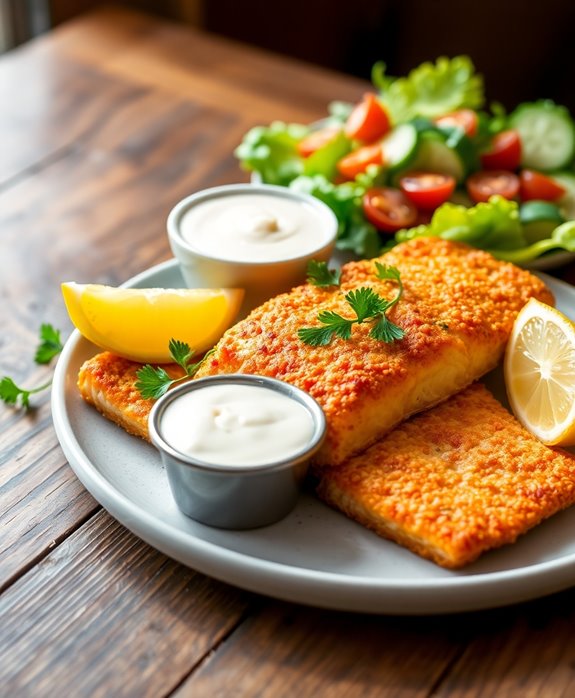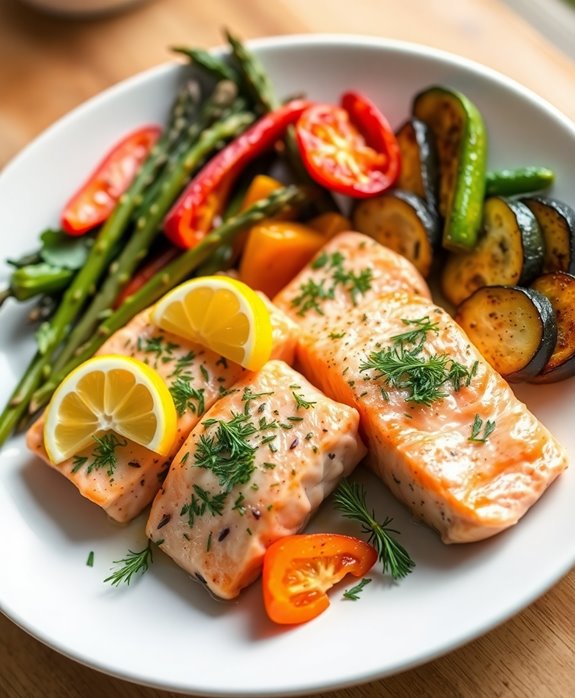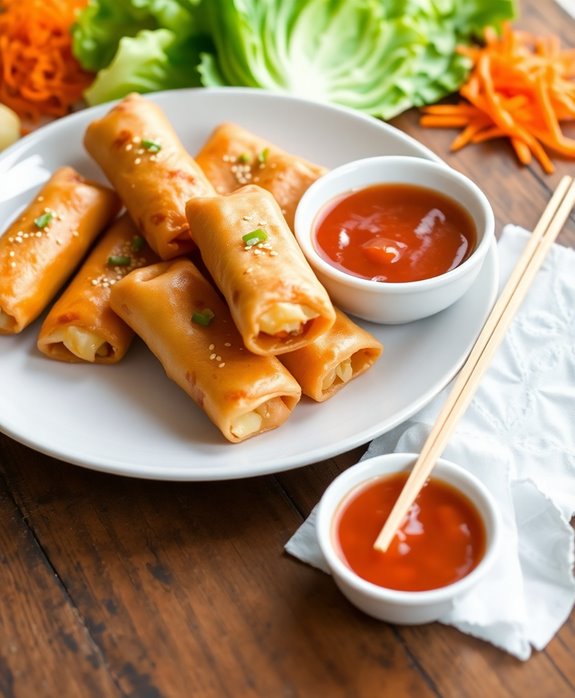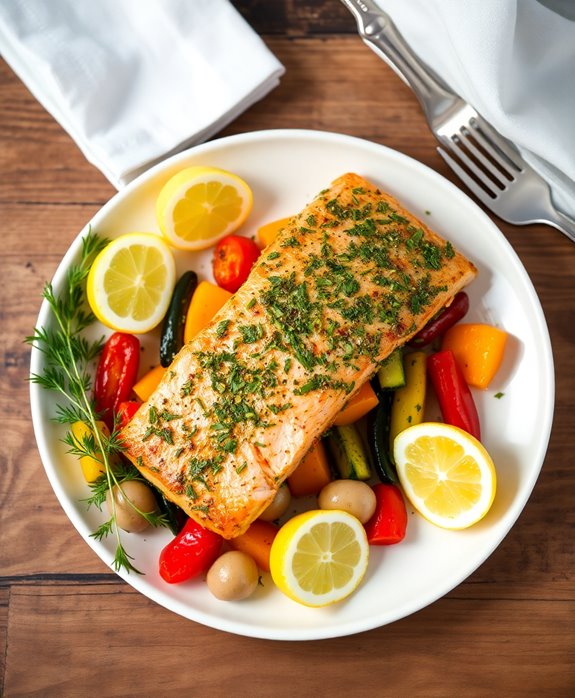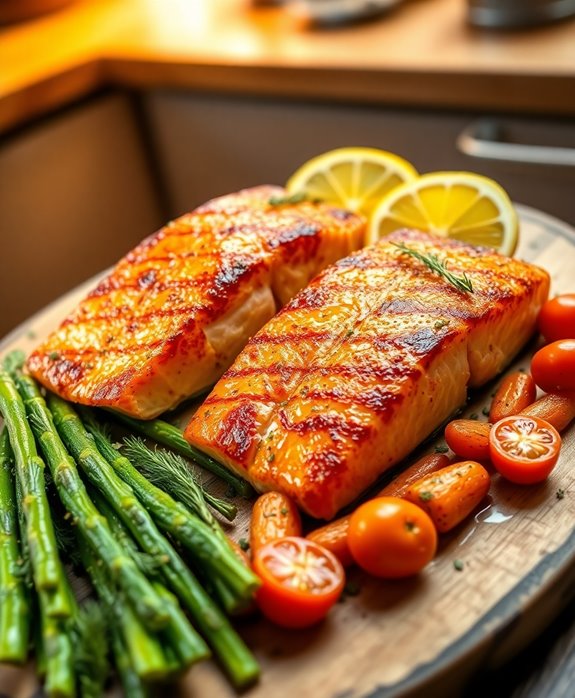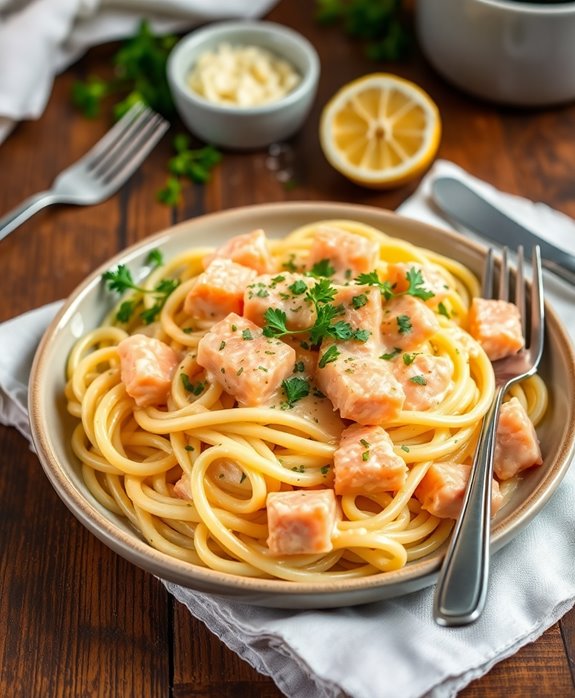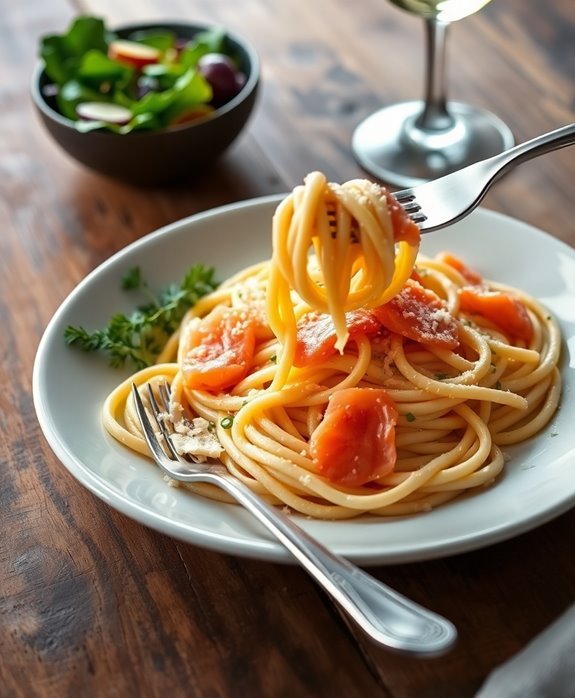Imagine the sound of crisping batter enveloping tender, flaky salmon as it sizzles in hot oil. You might think deep frying is reserved for indulgent treats, but this technique transforms salmon into a surprisingly elegant dish. With the right seasoning and a careful approach, you can achieve a balance of flavors and textures that elevate a simple meal. Curious about how to master this dish and its nutritional benefits? Let’s explore the steps and secrets behind creating a perfectly deep-fried salmon that promises to impress.
Tips and Tricks
- Rinse and pat dry 2 salmon fillets, removing any pin bones, then season with salt and pepper.
- Coat the salmon in seasoned flour, then dip in egg wash, and return to flour for a thicker crust.
- Heat oil to 350°F (175°C) and carefully fry salmon fillets for 4-6 minutes until golden and crispy.
- Drain fried salmon on paper towels and serve with lemon or your favorite dipping sauce for added flavor.
- Pair with a side salad or roasted vegetables for a balanced meal, ensuring healthy oil choices for frying.
History
The history of deep-frying fish, particularly salmon, stretches back centuries and spans various cultures around the globe. You mightn’t realize it, but the origins of salmon consumption date back to ancient civilizations. Early people relied on salmon for sustenance, often preparing it using various techniques, including smoking and drying.
As cultures evolved, so did the methods of cooking, with frying emerging as a popular option. In regions like Japan and Scandinavia, people began experimenting with frying techniques, creating crispy, golden brown exteriors that complemented salmon’s rich flavor.
You can see this reflected in traditional recipes that feature tempura-style frying or the use of batter. These techniques not only enhance the taste but also preserve the fish’s natural moisture.
As you explore the world of deep-fried salmon, you’ll discover how different cultures have added their twists, from unique seasonings to innovative frying methods. By understanding these historical influences, you can appreciate the dish’s depth and complexity. Additionally, the popularity of fried salmon has surged in recent years due to its deliciously crispy texture, which appeals to a wide audience.
Recipe
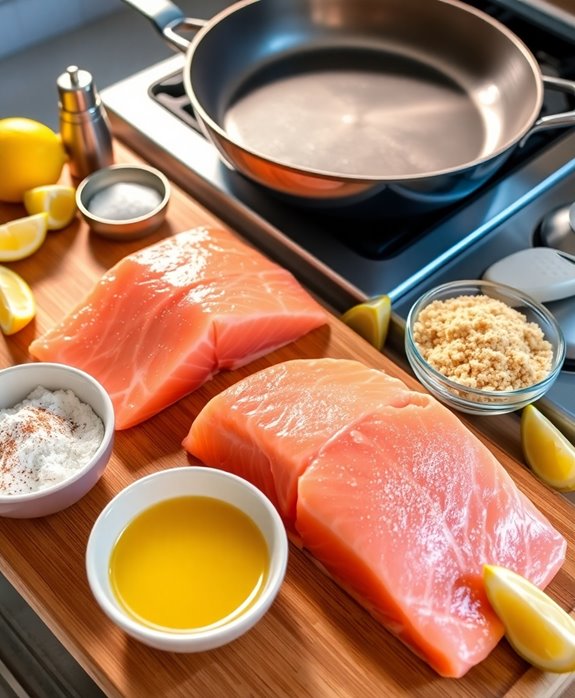
Deep-fried salmon is a delicious and indulgent way to enjoy this nutritious fish. The crispy exterior combined with the tender, flaky interior creates a delightful contrast that’s sure to impress at your dinner table or during a casual gathering. This cooking method enhances the natural flavors of salmon while allowing for a variety of seasonings and marinades to elevate the dish even further. Serve it with your favorite dipping sauces or alongside a fresh salad to complete the meal.
Before you start, it’s important to select high-quality salmon fillets. Wild-caught salmon is preferred for its rich flavor and firmer texture, but farmed salmon can also be used if that’s what you have on hand. Marinating the fish for a short period can add extra flavor, but even a simple seasoning of salt and pepper will work wonders. Incorporating savory seasonings can further enhance the taste and aroma of the dish.
Once you’re ready to fry, ensuring your oil is at the right temperature is key to achieving that perfect crispy finish without overcooking the fish.
Ingredients:
- 2 salmon fillets
- 1 cup all-purpose flour
- 1 cup breadcrumbs (Panko for extra crunch)
- 2 large eggs
- 1 teaspoon salt
- 1/2 teaspoon black pepper
- 1 teaspoon garlic powder
- 1 teaspoon paprika
- Oil for frying (canola or vegetable oil)
- Lemon wedges (for serving)
Instructions:
Begin by patting the salmon fillets dry with paper towels and seasoning them lightly with salt and pepper.
Set up a breading station with three shallow bowls: one with flour mixed with garlic powder and paprika, one with beaten eggs, and the last with breadcrumbs.
Dredge each salmon fillet in the flour mixture, ensuring it’s well-coated, then dip it into the beaten eggs before finally coating it with breadcrumbs.
Heat the oil in a deep pan or fryer until it reaches 350°F (175°C). Carefully place the breaded salmon fillets into the hot oil and fry for about 4-5 minutes per side or until golden brown and cooked through.
Remove the fillets and drain them on paper towels before serving.
Tips:
For the best results, make sure your oil is hot enough before adding the salmon; otherwise, the fillets may absorb too much oil and become soggy.
Use a thermometer to monitor the oil temperature closely. If you’re cooking multiple batches, allow the oil to return to the proper temperature between batches.
Additionally, you can experiment with different seasonings or marinades to customize the flavor profile of your deep-fried salmon. Enjoy your meal with a squeeze of fresh lemon juice for an extra burst of flavor!
Cooking Steps
To start, you’ll want to prepare the salmon fillets by patting them dry and trimming any excess skin.
Next, season them with fresh lemon zest for a bright flavor before coating each fillet in seasoned flour. Additionally, marinating the salmon in a mix of herbs can enhance the flavor profile significantly, making for a deliciously tender and flavorful dish.
Once that’s done, heat your oil to 350°F, and you’re ready to fry!
Step 1. Prepare the Salmon Fillets
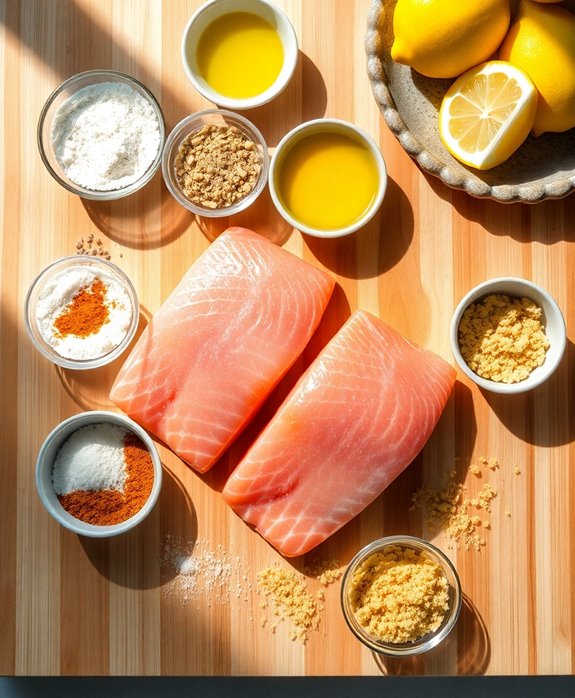
Begin by rinsing the salmon fillets under cold water, guaranteeing any residual scales or debris are removed.
Pat the fillets dry with paper towels to eliminate excess moisture, which can affect the frying process. If you’re using different salmon varieties like sockeye or king, note that their flavors and textures may vary, so choose the one that suits your taste.
Next, check for any pin bones in the fillets. You can easily find these by running your fingers along the flesh.
Use a pair of tweezers to remove any bones you encounter. This step guarantees a pleasant eating experience.
Once the fillets are clean and deboned, consider how you’d like to cut them. You can leave them whole or slice them into smaller portions, depending on your preference and the cooking techniques you plan to use.
For deep frying, smaller pieces tend to cook more evenly and quickly.
After prepping, place the fillets on a plate and let them rest for a few minutes. This rest period allows the salmon to come to room temperature, promoting an even cooker during frying.
Including the flavorful salmon belly in your dish can enhance the overall taste and texture.
Now, you’re ready to move on to seasoning!
Step 2. Season With Lemon Zest
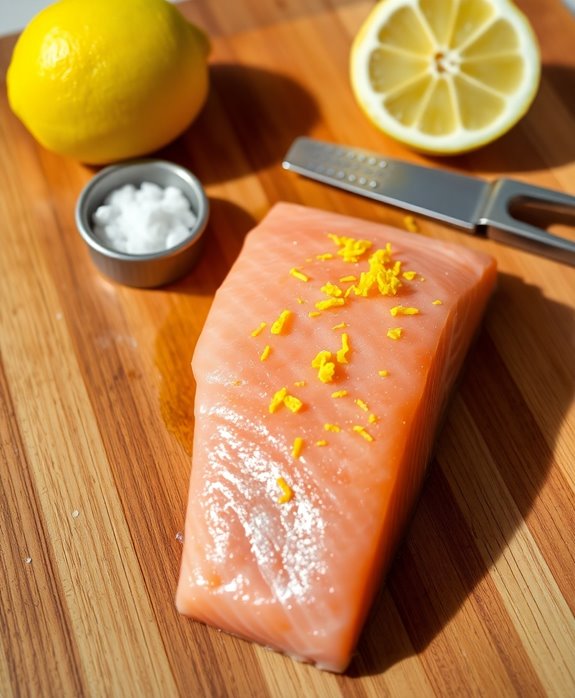
With the salmon fillets prepped and ready, it’s time to enhance their flavor with lemon zest. Start by washing a fresh lemon under cool water to remove any wax or pesticides.
Once clean, use a microplane or zester to carefully remove the bright yellow outer layer of the lemon peel, avoiding the bitter white pith underneath. You’ll want about one to two teaspoons of zest for the salmon, which will elevate the dish with its vibrant citrus aroma and flavor.
Sprinkle the freshly grated lemon zest evenly over the salmon fillets. This simple step not only adds an invigorating brightness but also brings numerous lemon benefits, like boosting your immune system and aiding digestion. Furthermore, lemon is known for its antioxidant properties, which can be particularly beneficial for managing diabetes.
The zest’s essential oils will infuse the fish, enhancing its natural taste. Use your fingers to gently massage the zest into the fillets, ensuring it adheres well.
This technique allows the flavors to meld beautifully as the salmon cooks. Now that your salmon is seasoned with lemon zest, it’s perfectly poised for the next step in your deep-frying adventure.
Enjoy the delightful combination of flavors that await!
Step 3. Coat in Seasoned Flour
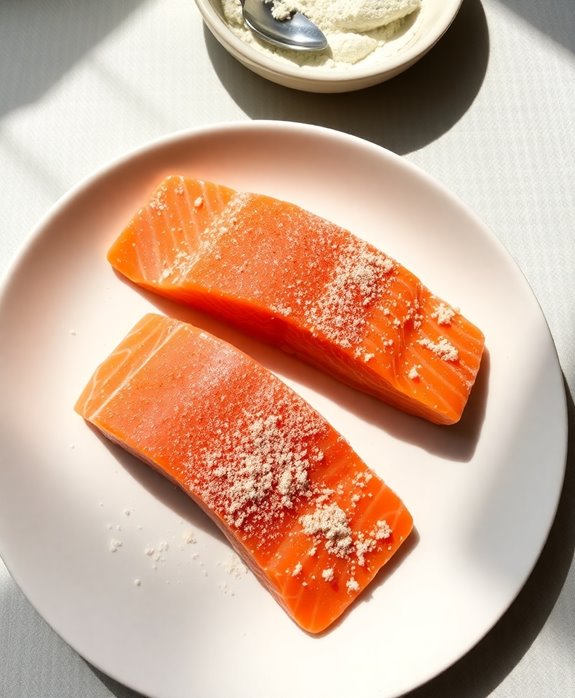
Now it’s time to create a crispy coating for your salmon fillets by coating them in seasoned flour. Start by selecting the right flour types; all-purpose flour works well, but you could also try rice flour for an extra crunch.
In a mixing bowl, combine about one cup of flour with your favorite seasoning blends. Consider using a mix of garlic powder, paprika, salt, and pepper to enhance the flavor profile.
Once your mixture is ready, take each salmon fillet and gently dredge it in the seasoned flour. Make sure to coat all sides evenly, pressing lightly to guarantee the flour adheres well.
If you want an even thicker crust, dip the fillets in a beaten egg wash before returning them to the flour mixture for a double coating. This technique will give your salmon an extra crispy texture once fried.
After coating, set the fillets aside on a plate or wire rack, allowing any excess flour to fall off. This step prevents clumping and guarantees a more uniform fry.
Interestingly, canned salmon can also be a great ingredient for creating a delicious meal if you want a quick alternative to fresh fillets.
With your salmon fillets perfectly coated, you’re one step closer to deep-frying perfection!
Step 4. Heat Oil to 350°F
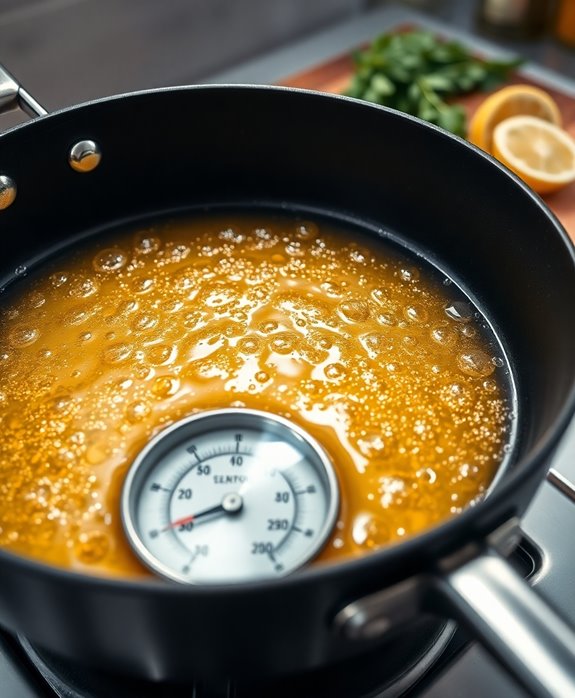
To achieve perfectly fried salmon, you’ll need to heat the oil to a precise temperature of 350°F.
Start by selecting a heavy-bottomed pot or deep fryer, as these will maintain consistent oil temperature during frying. Pour in enough oil to submerge the salmon, typically around 2–3 inches deep.
Use a reliable kitchen thermometer to monitor the oil’s temperature. If you don’t have one, try the wooden spoon technique: dip the end of a wooden spoon into the oil—bubbles forming around the spoon indicate that it’s hot enough.
Turn on the heat to medium-high, allowing the oil to gradually warm up. As the oil approaches 350°F, watch closely to prevent overheating. If the oil gets too hot, it can lead to burnt salmon and unpleasant flavors. Additionally, ensure that the salmon is not overly wet before frying, as excess moisture can affect the frying process and result in less crispy skin.
Once the thermometer reads 350°F, you’re ready to employ effective frying techniques. This temperature guarantees that the batter crisps up beautifully while the salmon cooks through evenly.
Step 5. Fry for Six Minutes
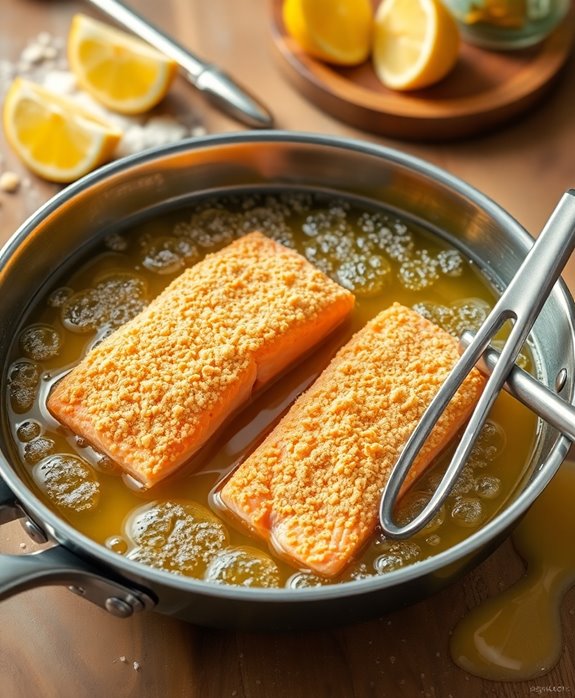
Carefully lower the salmon fillets into the hot oil, ensuring they don’t touch each other to allow for even cooking. This step is essential for achieving that perfect crispy texture.
Once submerged, keep an eye on the clock; you’ll want to fry the salmon for exactly six minutes. The oil, heated to 350°F, cooks the fish quickly while sealing in its natural flavors and nutrients.
As the salmon fries, you’ll notice a golden crust forming. This crust not only adds texture but also helps maintain the fish’s moisture, reducing the risk of dryness. The frying method also enhances the omega-3 fatty acids content, which are known for their heart-healthy properties.
Remember, the salmon benefits from this frying technique, as it locks in omega-3 fatty acids, known for their heart-healthy properties.
After six minutes, use a slotted spatula to gently lift the salmon from the oil. Allow it to drain on a paper towel for a moment before serving. This step helps remove excess oil, ensuring a lighter dish.
Serve your deep-fried salmon with a squeeze of lemon or your favorite dipping sauce, and enjoy the deliciously crispy exterior combined with the tender, flavorful fish inside.
Nutrition Facts
When you plunge into a serving of deep-fried salmon, you’re not just enjoying a delicious meal; you’re also treating your body to a range of essential nutrients.
Salmon is packed with high-quality protein, which is vital for muscle repair and overall health. Each bite delivers omega-3 fatty acids, known for their heart health benefits, including lowering inflammation and supporting brain function.
In terms of vitamins, deep-fried salmon is a great source of B vitamins, particularly B12, which plays a key role in energy production and maintaining healthy nerve cells. Additionally, it contains vitamin D, important for bone health and immune function.
For serving suggestions, consider pairing your deep-fried salmon with a side of steamed vegetables or a fresh salad to enhance the meal’s nutritional profile. Adding Sitka salmon recipes can also provide variety and new flavors to enjoy.
You might also add a squeeze of lemon for a burst of vitamin C, which can help boost your immune system.
Final Thoughts
Enjoying deep-fried salmon isn’t just about the taste; it’s also about reaping the benefits of its rich nutrient profile. Salmon is packed with omega-3 fatty acids, which are crucial for heart health and brain function. When you deep fry it, you enhance the flavor while still preserving those essential nutrients. Additionally, incorporating Copper River Salmon into your recipe can elevate the dish due to its exceptional quality and flavor.
Just remember to choose a healthy oil, like avocado or coconut, to keep things on the nutritious side.
For serving suggestions, consider pairing your deep-fried salmon with a revitalizing side salad or some roasted vegetables. The crunch of the salmon complements the crispness of fresh greens perfectly. You can also serve it with a zesty dipping sauce, such as a lemon garlic aioli, to elevate the dish further.
Don’t forget about portion control; while deep-fried salmon is delicious, enjoying it in moderation guarantees you’ll savor its health benefits without overindulging.
Experiment with different seasonings or marinades to customize your dish, making each meal a unique experience. In the end, deep-fried salmon can be a delightful, nutritious part of your culinary repertoire, bringing joy and health to your table.
Frequently Asked Questions
Can I Use Frozen Salmon for Deep Frying?
You’d think frozen salmon wouldn’t fry well, but it can! Just thaw it first, pat it dry, then coat fit or deep frying. You’ll bask in crispy, flavorful results that’ll have everyone guessing your secret.
What Oil Is Best for Deep Frying Salmon?
For deep frying salmon, use oils with high smoke points like canola or peanut oil. Heat the oil to around 350°F for crispy results. Avoid oils that burn easily to guarantee a delicious fry.
How Can I Make the Coating More Flavorful?
To make your coating more flavorful, mix spice blends like paprika or garlic powder into flour. You can also try herb infusions, adding fresh herbs like dill or parsley to enhance the taste and aroma.
What Sides Pair Well With Deep Fried Salmon?
To elevate your meal, pair deep-fried salmon with crispy garlic potatoes or a fresh cucumber salad. These sides balance the rich flavor profiles and cooking techniques, enhancing your dish’s overall taste and texture. Enjoy!
Can I Use an Air Fryer Instead of Deep Frying?
Sure, you can use an air fryer instead of deep frying! You’ll enjoy air fryer benefits like less oil and shorter cooking time, giving you crispy perfection without the mess of traditional frying. Enjoy that guilt-free crunch!

